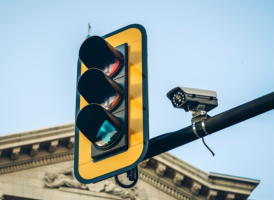IoT in Government Use Cases and Applications
By Enrico Marongiu
August 3, 2023
By Enrico Marongiu
August 3, 2023

Governing bodies are looking for ways to increase efficiency and become more sustainable, considering current trends that include:
To accomplish this, many institutions and agencies are utilizing Internet of Things (IoT) technology and IoT-enabled devices. Such devices include embedded sensors and cameras that collect and analyze data. This data provides instrumental insights to enhance complex processes.
Here are some of the most common use cases and applications of IoT in government and the public sector.

Governments are rolling out IoT smart energy solutions like smart meters to digitize and modernize the energy sector. These meters use cellular technology to gather real-time data and send it to energy companies. As a result, operators no longer need to perform on-site meter readings and bill estimates. Moreover, these insights give government agencies a better understanding of energy consumption and generation to make more informed decisions.
IoT in the government sector is also used to create smart waste and water management programs. For example, operators can monitor garbage disposal by installing IoT sensors inside trucks to decrease truck rolls.
Security plays a fundamental role in these scenarios, as malicious attackers could leverage the physical or wireless access to the device to:
Moreover, in case of a crisis or natural disaster, it is crucial to guarantee that all systems and equipment are under monitoring and control.

In recent decades, national and international threats have become more complex and prolific. IoT empowers federal, state and local agencies to keep their citizens safe. IoT surveillance cameras and monitoring devices can, for example, aid in reducing human and drug trafficking. Police can also reduce crime within cities.
France, Spain and North Africa use IoT technology to improve border security through real-time alerts. In addition, IoT solutions are invaluable to military systems and services, enhancing national defense efforts.
Governments can leverage IoT to improve emergency response to natural disasters. IoT devices and sensors can study trends and detect anomalies for smarter environmental disaster management. This data enables faster rescue operations and improved prevention projects. Furthermore, IoT real-time capabilities for digital signage can deliver accurate evacuation information.

Another common area where governments and the public sector rely on IoT solutions is transportation and infrastructure. In busy smart cities, data collected from connected traffic lights and vehicles can achieve a comprehensive traffic overview to reduce accidents and accelerate commutes. Plus, smart parking solutions can communicate space availability and enable automatic payments for greater convenience.
Governments can also make their public transportation systems more efficient, safe and clean. IoT monitoring solutions allow engineers and operators to determine if machinery needs repair and prevent catastrophic failure.
In addition, these same devices can monitor road and bridge integrity and notify relevant personnel of potential hazards and structural issues. Real-time surveillance can also minimize crime onboard trains and buses.
Government agencies can also use IoT technology to automate habitual and manual processes. This automation would enhance accuracy and speed.
Nevertheless, governments and related entities must consider several challenges with their IoT deployments. These challenges include the massive data volumes and the enormous number of devices and sensors involved.
It’s crucial to design and implement an appropriate data management strategy and select either an on-premises or hybrid cloud architecture. In addition, the strategy must include a potential roadmap to transition from on-premises to hybrid cloud or from one cloud vendor to another.
IoT security vulnerabilities will become more impactful as society and systems become more dependent on digital capabilities. A zero-trust approach must be followed and choosing the right hardware vendor and software provider is critical for a better, safer world.
Partner with a proven IoT leader to build smarter security, infrastructure and transportation systems. Leverage our IoT modules and connectivity plans and services for your next government or public sector application.